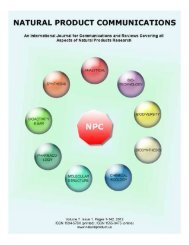This Issue is Dedicated to the Memory of Professor Ivano Morelli
This Issue is Dedicated to the Memory of Professor Ivano Morelli
This Issue is Dedicated to the Memory of Professor Ivano Morelli
Create successful ePaper yourself
Turn your PDF publications into a flip-book with our unique Google optimized e-Paper software.
4-Oxo fatty acids Hygrophorus d<strong>is</strong>coxanthus Natural Product Communications Vol. 1 (12) 2006 1081<br />
pro<strong>to</strong>ns and carbons counted from <strong>the</strong> NMR spectra.<br />
Remarkably, <strong>the</strong> 1 H NMR spectrum <strong>of</strong> 3 did not<br />
contain <strong>the</strong> character<strong>is</strong>tic signals <strong>of</strong> <strong>the</strong> cross<br />
conjugated dienone system <strong>of</strong> 1 and 2; instead, three<br />
overlapping multiplets, each integrating for 2H, were<br />
found between δ 2.60-2.82, and were attributed <strong>to</strong><br />
three different methylene groups adjacent <strong>to</strong> ei<strong>the</strong>r<br />
saturated carbonyl or carboxylic groups. <strong>Th<strong>is</strong></strong><br />
assignment was confirmed by <strong>the</strong> resonances at<br />
δ 177.4 and 209.7 in <strong>the</strong> 13 C NMR spectrum,<br />
attributed <strong>to</strong> <strong>the</strong> carbons <strong>of</strong> a carboxylic acid and a<br />
saturated ke<strong>to</strong>ne, respectively. In addition, a broad<br />
multiplet at δ 4.10 (1H), which was correlated <strong>to</strong> a<br />
carbon at δ 67.7 in <strong>the</strong> HSQC spectrum, was firmly<br />
assigned <strong>to</strong> a secondary alcohol. The presence <strong>of</strong> an<br />
internal, non-conjugated, d<strong>is</strong>ubstituted olefin was<br />
demonstrated by an end absorption band at λ max =<br />
218 nm in <strong>the</strong> UV spectrum, along with <strong>the</strong> 13 C NMR<br />
signals <strong>of</strong> two methines at δ 129.3 and 130.1, which<br />
were correlated <strong>to</strong> an NMR signal at δ 5.25-5.45 in<br />
<strong>the</strong> HSQC spectrum. The AB coupling constant <strong>of</strong><br />
10.5 Hz <strong>of</strong> <strong>the</strong>se two pro<strong>to</strong>ns proved <strong>the</strong><br />
Z-configuration <strong>of</strong> <strong>the</strong> double bond. A homonuclear<br />
COSY experiment, and two and three bonds HMBC<br />
correlations (Figure 3) allowed establ<strong>is</strong>hment <strong>of</strong> <strong>the</strong><br />
1,4-relationship <strong>of</strong> <strong>the</strong> carboxylic group with <strong>the</strong><br />
ke<strong>to</strong>ne, and <strong>the</strong> 1,3-relationship <strong>of</strong> <strong>the</strong> hydroxyl and<br />
carbonyl groups.<br />
NMR data alone left <strong>the</strong> position <strong>of</strong> <strong>the</strong> internal<br />
double bond undetermined. Therefore, compound 3<br />
was exposed <strong>to</strong> ozone and, after work-up, <strong>the</strong> crude<br />
reaction mixture was directly subjected <strong>to</strong> GC<br />
analys<strong>is</strong>. Compar<strong>is</strong>on with an au<strong>the</strong>ntic sample<br />
revealed heptanal <strong>to</strong> be formed by ozonolys<strong>is</strong> <strong>of</strong><br />
olefin 3. From all results, <strong>the</strong> structure <strong>of</strong> compound<br />
3 was establ<strong>is</strong>hed as (Z)-6-hydroxy-4-oxo-octadec-<br />
11-enoic acid.<br />
OH<br />
Figure 3: Selected HMBC correlations <strong>of</strong> compound 3.<br />
O<br />
O<br />
OH<br />
The NMR data <strong>of</strong> compounds 4 and 5 were closely<br />
related <strong>to</strong> 3 as regards <strong>to</strong> <strong>the</strong> 6-hydroxy-4-oxocarboxylic<br />
acid [C(1)–C(6)] unit. In contrast, o<strong>the</strong>r<br />
than compound 3, <strong>the</strong> acids 4 and 5 did not show <strong>the</strong><br />
signals <strong>of</strong> an internal double bond. Instead, in <strong>the</strong> 1 H<br />
NMR spectrum <strong>of</strong> compound 4, <strong>the</strong> pattern <strong>of</strong> signals<br />
from a three spin system at δ 4.95, 4.99, and 5.83,<br />
almost identical <strong>to</strong> that <strong>of</strong> acid 2 (see above) were<br />
due <strong>to</strong> a terminal double bond. On <strong>the</strong> o<strong>the</strong>r hand,<br />
compound 5 contains a fully saturated fatty acid-like<br />
chain, as indicated, in <strong>the</strong> 1 H NMR spectrum, by <strong>the</strong><br />
character<strong>is</strong>tic d<strong>is</strong><strong>to</strong>rted triplet (J = 6.8 Hz) at δ 0.88,<br />
assigned <strong>to</strong> <strong>the</strong> terminal methyl group, and by a broad<br />
peak at δ 1.20-1.60, assigned <strong>to</strong> <strong>the</strong> methylenes in <strong>the</strong><br />
chain. From <strong>the</strong> mass spectral data, <strong>the</strong> length <strong>of</strong> <strong>the</strong><br />
chain in both compounds 4 and 5 could be<br />
determined as C 16 , thus permitting assignment <strong>of</strong> <strong>the</strong><br />
structure <strong>of</strong> 6-hydroxy-4-oxo-hexadec-15-enoic acid<br />
<strong>to</strong> 4, and <strong>of</strong> 6-hydroxy-4-oxo-hexadecanoic acid <strong>to</strong> 5.<br />
The absolute configuration <strong>of</strong> carbinols 3-5 has yet <strong>to</strong><br />
be determined. Compounds 1-5 have never been<br />
<strong>is</strong>olated from a natural source; acid 5 was obtained<br />
previously as a racemate by syn<strong>the</strong>s<strong>is</strong> [11].<br />
A preliminary qualitative test indicated that acids 1<br />
and 2 are moderately fungicidal against <strong>the</strong><br />
phy<strong>to</strong>pathogenic fungus Cladosporium cucumerinum<br />
Ell. et Arth..<br />
The structures 1-5 are closely related <strong>to</strong> o<strong>the</strong>r<br />
oxidized C 16 -C 22 fatty acids and <strong>the</strong>ir derivatives<br />
recently <strong>is</strong>olated from a few Hygrophorus species<br />
[3-5], for which hypo<strong>the</strong>tical biogenetic relationships<br />
have been proposed [3,5]. A rare feature <strong>of</strong> all <strong>the</strong>se<br />
structures <strong>is</strong> <strong>the</strong> oxidation <strong>to</strong> a ke<strong>to</strong>ne <strong>of</strong> <strong>the</strong> C-4 <strong>of</strong><br />
<strong>the</strong> parent fatty acid; a few compounds show an<br />
additional site-specific oxidation at C-6, which <strong>the</strong><br />
optically active alcohols 3-5 indicate <strong>to</strong> occur under<br />
enzyme control. Indeed, 6-hydroxy-4-oxo-carboxylic<br />
acids like 3-5 are, <strong>to</strong> our knowledge, unprecedented<br />
in nature. They can be considered advanced<br />
biogenetic precursors <strong>of</strong> hygrophorones F 12 and G 12<br />
[4a]. Examining <strong>the</strong> literature data, it was concluded<br />
that each Hygrophorus species <strong>is</strong> characterized by its<br />
own pattern <strong>of</strong> oxidized C 16 -C 22 fatty acid derivatives,<br />
which may thus be considered a significant<br />
chemotaxonomic marker. Moreover, due <strong>to</strong> <strong>the</strong><br />
fungicidal and bactericidal properties [3-5], <strong>the</strong>se<br />
metabolites likely function as “chemical deterrents”,<br />
protecting Hygrophorus fruiting bodies against <strong>the</strong><br />
attack <strong>of</strong> parasites and preda<strong>to</strong>rs.<br />
Experimental<br />
General experimental procedures: Optical rotations<br />
were determined on a Perkin-Elmer 241 polarimeter;<br />
IR spectra were recorded on an FT-IR Perkin Elmer<br />
Paragon 1000 PC spectrometer as neat films on NaCl







